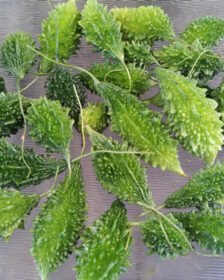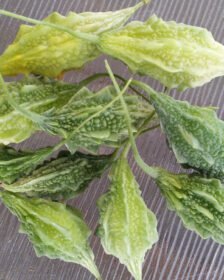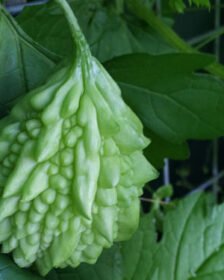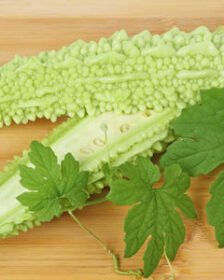Bitter Melon/Bitter Gourd
Showing all 9 results
-
Asian Long Bitter Melon – Pinyin, Pare, Paakharkaai, Karela – 6 Seeds
$3.50Quick ViewAsian Long Bitter Melon / Bitter Gourd (Pinyin, Pare, Paakharkaai, Kaakarakaya, Karela) – 6 Seeds
They are one of the most high yield & less bitter melon variety from Asia. One single bitter melon can grow up to 35cm in length and 600 grams in weight and comes with the same nutritional value. They are fairly easy to grow and needs support for the vines. With proper care this plant will produce heaps of large sized bitter melon for months.
Bitter melon is often used in Chinese cooking for its bitter flavour, typically in stir-fries (often with pork and douchi), soups, and also as tea. It has also been used in place of hops as the bittering ingredient in some Chinese beers. It is very popular throughout South Asia. In Northern India, it is often prepared with potatoes and served with yogurt on the side to offset the bitterness, or used in sabji. In North Indian cuisine it is stuffed with spices and then cooked in oil.*.
International Buyers:
If the postage is lost in transit and you do not receive them or your country’s custom confiscate the seeds, I won’t be responsible for it. You will not be refunded nor resend the seeds again. Please do not buy the seeds if you are not agreed to this terms. If you want me send through registered post, please contact me before you pay for the item.Sowing Instructions:
Seeds need min 20°C to germinate. Soak the seeds in water for a few hours before planting and sow them between 15mm deep in a sunny, well-drained position. Germinates between 2-4 weeks. Grow indoor in extreme weather condition and then transfer when mature enough to survive. Give the vines enough support for their vigorous growth.Due to quarantine restrictions, seeds can’t be sent to Tasmania.
Bitter gourds are very low in calories but dense with precious nutrients. It is an excellent source of vitamins B1, B2, and B3, C, magnesium, folic acid, zinc, phosphorus, manganese, and has high dietary fiber. It is rich in iron, contains twice the beta-carotene of broccoli, twice the calcium of spinach, and twice the potassium of a banana.
Bitter melon contains a unique phyto-constituent that has been confirmed to have a hypoglycemic effect called charantin. There is also another insulin-like compound known as polypeptide P which have been suggested as insulin replacement in some diabetic patients.
* Nutrient Source:
http://en.wikipedia.org/wiki/Bitter_melon
http://www.juicing-for-health.com
http://www.juicing-for-health.com/bitter-gourd-benefits.html -
Bitter Melon (Pinyin, Pare, Paakharkaai, Kaakarakaya, Karela) – 5 Seeds
$3.99Quick ViewBitter Melon / Bitter Gourd (Pinyin, Pare, Paakharkaai, Kaakarakaya, Karela) – 5 Seeds
They are very easy to grow & easy to maintain. The plant can produce heaps of small sized bitter melon for months.
Bitter melon is often used in Chinese cooking for its bitter flavor, typically in stir-fries (often with pork and douchi), soups, and also as tea. It has also been used in place of hops as the bittering ingredient in some Chinese beers. It is very popular throughout South Asia. In Northern India, it is often prepared with potatoes and served with yogurt on the side to offset the bitterness, or used in sabji. In North Indian cuisine it is stuffed with spices and then cooked in oil.*.
Best time to sow seeds after frost. Seeds need min 20°C to germinate. Soak the seeds in water for a few hours before planting and sow them in 10mm deep in a sunny, well-drained position. Germinates between 10-14 days. Sow them 35-50cm apart. Enjoy your harvest approx 70 days from transplanting.
________________________________________
Due to quarantine restrictions, seeds can’t be sent to Tasmania.
Bitter gourds are very low in calories but dense with precious nutrients. It is an excellent source of vitamins B1, B2, and B3, C, magnesium, folic acid, zinc, phosphorus, manganese, and has high dietary fiber. It is rich in iron, contains twice the beta-carotene of broccoli, twice the calcium of spinach, and twice the potassium of a banana.Bitter melon contains a unique phyto-constituent that has been confirmed to have a hypoglycemic effect called charantin. There is also another insulin-like compound known as polypeptide P which have been suggested as insulin replacement in some diabetic patients.
-
Bitter Melon (Pinyin, Pare, Paakharkaai, Kaakarakaya, Karela) – 5 Seeds
$3.99Quick ViewBitter Melon / Bitter Gourd (Pinyin, Pare, Paakharkaai, Kaakarakaya, Karela) – 5 Seeds
They are very easy to grow & easy to maintain. The plant can produce heaps of small sized bitter melon for months.
Bitter melon is often used in Chinese cooking for its bitter flavor, typically in stir-fries (often with pork and douchi), soups, and also as tea. It has also been used in place of hops as the bittering ingredient in some Chinese beers. It is very popular throughout South Asia. In Northern India, it is often prepared with potatoes and served with yogurt on the side to offset the bitterness, or used in sabji. In North Indian cuisine it is stuffed with spices and then cooked in oil.*.
Best time to sow seeds after frost. Seeds need min 20°C to germinate. Soak the seeds in water for a few hours before planting and sow them in 10mm deep in a sunny, well-drained position. Germinates between 10-14 days. Sow them 35-50cm apart. Enjoy your harvest approx 70 days from transplanting.
________________________________________
Due to quarantine restrictions, seeds can’t be sent to Tasmania.
Bitter gourds are very low in calories but dense with precious nutrients. It is an excellent source of vitamins B1, B2, and B3, C, magnesium, folic acid, zinc, phosphorus, manganese, and has high dietary fiber. It is rich in iron, contains twice the beta-carotene of broccoli, twice the calcium of spinach, and twice the potassium of a banana.Bitter melon contains a unique phyto-constituent that has been confirmed to have a hypoglycemic effect called charantin. There is also another insulin-like compound known as polypeptide P which have been suggested as insulin replacement in some diabetic patients.
* Nutrient Source:
Wikipedia.org
http://en.wikipedia.org/wiki/Bitter_melonwww.juicing-for-health.com
http://www.juicing-for-health.com/bitter-gourd-benefits.html -
RARE Light Green Asian Bitter Melon (Pinyin, Pare, Paakharkaai, Karela)- 5 Seeds
$3.50Quick ViewRARE Light Green Asian Bitter Melon / Bitter Gourd (Momordica Charantia) – 5 Seeds
They are one of the RAREST and super nutritious bitter melon found in south-east Asia. They are very less bitter and nearly white than the other bitter melon variety but comes with even more nutritional value.
For best colour and yield please plant them part sun part shed area.
Bitter melon is often used in Indian/Chinese cooking for its bitter flavour, typically in stir-fries (often with pork and douchi), soups, and also as tea. It has also been used in place of hops as the bittering ingredient in some Chinese beers. It is very popular throughout South Asia. In Northern India, it is often prepared with potatoes and served with yoghurt on the side to offset the bitterness, or used in sabji. In North Indian cuisine it is stuffed with spices and then cooked in oil.* This bitter melon is a traditional ingredient in Asian medicine and cuisine. Its most basic use is to help with gastrointestinal issues. In the United States, studies have shown that it can help people who are coping with diabetes. Extracts of the fruit also might help prevent and treat cancer and malaria!!!
If this variety did not exist a pharmaceutical company would invent it. In fact, there have been some ten studies published this past year about it, the latest as of this writing in February 2008 in the Journal of Food Biochemistry about its potential in diabetes treatment. Source
They are very easy to grow & easy to maintain. The plant can produce heaps of good sized bitter melon for months. Best time to sow seeds after frost. Seeds need min 20°C to germinate. Soak the seeds in water for a few hours before planting and sow them in 10mm deep in a sunny, well-drained position. Germinates between 10-14 days. Sow them 35-50cm apart. Enjoy your harvest approx 70 days from transplanting.
________________________________________
Due to quarantine restrictions, seeds can’t be sent to Tasmania.
Bitter gourds are very low in calories but dense with precious nutrients. It is an excellent source of vitamins B1, B2, and B3, C, magnesium, folic acid, zinc, phosphorus, manganese, and has high dietary fiber. It is rich in iron, contains twice the beta-carotene of broccoli, twice the calcium of spinach, and twice the potassium of a banana.Bitter melon contains a unique phyto-constituent that has been confirmed to have a hypoglycemic effect called charantin. There is also another insulin-like compound known as polypeptide P which have been suggested as insulin replacement in some diabetic patients.
* Nutrient Source:
Wikipedia.org
http://en.wikipedia.org/wiki/Bitter_melonwww.juicing-for-health.com
http://www.juicing-for-health.com/bitter-gourd-benefits.html -
RARE Long Bitter Melon (Pinyin, Pare, Paakharkaai, Karela) – 6 Seeds
$3.99Quick ViewRARE Long Bitter Melon / Bitter Gourd (Pinyin, Pare, Paakharkaai, Kaakarakaya, Karela) – 6 Seeds
They are one of the RAREST long bitter melon only found in some part of Asia. They are very less bitter than the other bitter melon variety but comes with the same nutritional value.
They are very easy to grow & easy to maintain. The plant can produce heaps of large sized bitter melon for months.
Bitter melon is often used in Chinese cooking for its bitter flavor, typically in stir-fries (often with pork and douchi), soups, and also as tea. It has also been used in place of hops as the bittering ingredient in some Chinese beers. It is very popular throughout South Asia. In Northern India, it is often prepared with potatoes and served with yogurt on the side to offset the bitterness, or used in sabji. In North Indian cuisine it is stuffed with spices and then cooked in oil.*.
Best time to sow seeds after frost. Seeds need min 20°C to germinate. Soak the seeds in water for a few hours before planting and sow them in 10mm deep in a sunny, well-drained position. Germinates between 10-14 days. Sow them 35-50cm apart. Enjoy your harvest approx 70 days from transplanting.
________________________________________
Due to quarantine restrictions, seeds can’t be sent to Tasmania.
Bitter gourds are very low in calories but dense with precious nutrients. It is an excellent source of vitamins B1, B2, and B3, C, magnesium, folic acid, zinc, phosphorus, manganese, and has high dietary fiber. It is rich in iron, contains twice the beta-carotene of broccoli, twice the calcium of spinach, and twice the potassium of a banana.Bitter melon contains a unique phyto-constituent that has been confirmed to have a hypoglycemic effect called charantin. There is also another insulin-like compound known as polypeptide P which have been suggested as insulin replacement in some diabetic patients.
* Nutrient Source:
Wikipedia.org
http://en.wikipedia.org/wiki/Bitter_melonwww.juicing-for-health.com
http://www.juicing-for-health.com/bitter-gourd-benefits.html -
Ultra Glowing White Long Bitter Melon – A Rare Variety that will Surprise You!
$3.50Quick ViewUltra Glowing White Long Bitter Melon – A Rare Variety that will Surprise You! – 5 Seeds
This is one of the RAREST and super nutritious bitter melon found in south-east Asia. They have beautiful glowing white colour and really less bitter than the other bitter melon variety but comes with even more nutritional value.
They are just glowing white colour. The best possible white colour ever for a bitter melon!
Bitter melon is often used in Indian/Chinese cooking for its bitter flavour, typically in stir-fries (often with pork and douchi), soups, and also as tea. It has also been used in place of hops as the bittering ingredient in some Chinese beers. It is very popular throughout South Asia. In Northern India, it is often prepared with potatoes and served with yoghurt on the side to offset the bitterness, or used in sabji. In North Indian cuisine it is stuffed with spices and then cooked in oil.* This bitter melon is a traditional ingredient in Asian medicine and cuisine. Its most basic use is to help with gastrointestinal issues. In the United States, studies have shown that it can help people who are coping with diabetes. Extracts of the fruit also might help prevent and treat cancer and malaria!!!
If this variety did not exist a pharmaceutical company would invent it. In fact, there have been some ten studies published this past year about it, the latest as of this writing in February 2008 in the Journal of Food Biochemistry about its potential in diabetes treatment. Source
They are very easy to grow & easy to maintain. The plant can produce heaps of good sized bitter melon for months. Best time to sow seeds after frost. Seeds need min 20°C to germinate. Soak the seeds in water for a few hours before planting and sow them in 10mm deep in a sunny, well-drained position. Germinates between 10-14 days. Sow them 35-50cm apart. Enjoy your harvest approx 70 days from transplanting.
________________________________________
Due to quarantine restrictions, seeds can’t be sent to Tasmania.
* Nutrient Source:
Wikipedia.org
http://en.wikipedia.org/wiki/Bitter_melonwww.juicing-for-health.com
http://www.juicing-for-health.com/bitter-gourd-benefits.html
Nutritional value:
Bitter gourds are very low in calories but dense with precious nutrients. It is an excellent source of vitamins B1, B2, and B3, C, magnesium, folic acid, zinc, phosphorus, manganese, and has high dietary fiber. It is rich in iron, contains twice the beta-carotene of broccoli, twice the calcium of spinach, and twice the potassium of a banana.
Bitter melon contains a unique phyto-constituent that has been confirmed to have a hypoglycemic effect called charantin. There is also another insulin-like compound known as polypeptide P which have been suggested as insulin replacement in some diabetic patients. -
Ultra Rare Black Bitter Melon – A High-Yielding Long Bitter Melon
$3.50Quick ViewUltra Rare Black Bitter Melon – A High-Yielding Long Bitter Melon Variety – 5 Seeds
They are heavy producer bitter melon variety from Asia. One single bitter melon can grow up to 30cm in length and 300 grams in weight and comes with the same nutritional value. They are fairly easy to grow and needs support for the vines. With proper care this plant will produce heaps of large sized bitter melon for months.
Bitter melon is often used in Chinese cooking for its bitter flavour, typically in stir-fries (often with pork and douchi), soups, and also as tea. It has also been used in place of hops as the bittering ingredient in some Chinese beers. It is very popular throughout South Asia. In Northern India, it is often prepared with potatoes and served with yogurt on the side to offset the bitterness, or used in sabji. In North Indian cuisine it is stuffed with spices and then cooked in oil.*.
International Buyers:
If the postage is lost in transit and you do not receive them or your country’s custom confiscate the seeds, I won’t be responsible for it. You will not be refunded nor resend the seeds again. Please do not buy the seeds if you are not agreed to this terms. If you want me send through registered post, please contact me before you pay for the item.
Sowing Instructions:
Seeds need min 20°C to germinate. Soak the seeds in water for a few hours before planting and sow them between 15mm deep in a sunny, well-drained position. Germinates between 2-4 weeks. Grow indoor in extreme weather condition and then transfer when mature enough to survive. Give the vines enough support for their vigorous growth.
________________________________________
Due to quarantine restrictions, seeds can’t be sent to Tasmania.
________________________________________
* Nutrient Source:
http://en.wikipedia.org/wiki/Bitter_melon
http://www.juicing-for-health.com
http://www.juicing-for-health.com/bitter-gourd-benefits.htmlBitter gourds are very low in calories but dense with precious nutrients. It is an excellent source of vitamins B1, B2, and B3, C, magnesium, folic acid, zinc, phosphorus, manganese, and has high dietary fiber. It is rich in iron, contains twice the beta-carotene of broccoli, twice the calcium of spinach, and twice the potassium of a banana.
Bitter melon contains a unique phyto-constituent that has been confirmed to have a hypoglycemic effect called charantin. There is also another insulin-like compound known as polypeptide P which have been suggested as insulin replacement in some diabetic patients.
-
Ultra RARE White Bitter Melon/Bitter Gourd (Beauty Winner) – A Must Have Variety
$3.99Quick ViewUltra RARE White Bitter Melon/Bitter Gourd (Beauty Winner) – 5 Seeds
This is one of the RAREST and super nutritious bitter melon found in south-east Asia. They are very less bitter and beautiful white colour and really less bitter than the other bitter melon variety but comes with even more nutritional value.
They are just glowing white colour. The best colour ever for a bitter melon!
Bitter melon is often used in Indian/Chinese cooking for its bitter flavour, typically in stir-fries (often with pork and douchi), soups, and also as tea. It has also been used in place of hops as the bittering ingredient in some Chinese beers. It is very popular throughout South Asia. In Northern India, it is often prepared with potatoes and served with yoghurt on the side to offset the bitterness, or used in sabji. In North Indian cuisine it is stuffed with spices and then cooked in oil.* This bitter melon is a traditional ingredient in Asian medicine and cuisine. Its most basic use is to help with gastrointestinal issues. In the United States, studies have shown that it can help people who are coping with diabetes. Extracts of the fruit also might help prevent and treat cancer and malaria!!!
If this variety did not exist a pharmaceutical company would invent it. In fact, there have been some ten studies published this past year about it, the latest as of this writing in February 2008 in the Journal of Food Biochemistry about its potential in diabetes treatment. Source
They are very easy to grow & easy to maintain. The plant can produce heaps of good sized bitter melon for months. Best time to sow seeds after frost. Seeds need min 20°C to germinate. Soak the seeds in water for a few hours before planting and sow them in 10mm deep in a sunny, well-drained position. Germinates between 10-14 days. Sow them 35-50cm apart. Enjoy your harvest approx 70 days from transplanting.
________________________________________
Due to quarantine restrictions, seeds can’t be sent to Tasmania.
* Nutrient Source:
Wikipedia.org
http://en.wikipedia.org/wiki/Bitter_melonwww.juicing-for-health.com
http://www.juicing-for-health.com/bitter-gourd-benefits.html
Nutritional value:
Bitter gourds are very low in calories but dense with precious nutrients. It is an excellent source of vitamins B1, B2, and B3, C, magnesium, folic acid, zinc, phosphorus, manganese, and has high dietary fiber. It is rich in iron, contains twice the beta-carotene of broccoli, twice the calcium of spinach, and twice the potassium of a banana.
Bitter melon contains a unique phyto-constituent that has been confirmed to have a hypoglycemic effect called charantin. There is also another insulin-like compound known as polypeptide P which have been suggested as insulin replacement in some diabetic patients. -
Ultra White Long Bitter Melon – A Must Have Rare Asian Variety
$3.99Quick ViewUltra White Long Bitter Melon – The Best Colour ever for a Long Bitter Melon! – 5 Seeds
This is one of the RAREST and super nutritious bitter melon found in south-east Asia. This is a long variety & can grow up to 30cm in length! They are very less bitter but comes with even more nutritional value. A must have variety for your backyard!
Bitter melon is often used in Indian/Chinese cooking for its bitter flavour, typically in stir-fries (often with pork and douchi), soups, and also as tea. It has also been used in place of hops as the bittering ingredient in some Chinese beers. It is very popular throughout South Asia. In Northern India, it is often prepared with potatoes and served with yoghurt on the side to offset the bitterness, or used in sabji. In North Indian cuisine it is stuffed with spices and then cooked in oil.* This bitter melon is a traditional ingredient in Asian medicine and cuisine. Its most basic use is to help with gastrointestinal issues. In the United States, studies have shown that it can help people who are coping with diabetes. Extracts of the fruit also might help prevent and treat cancer and malaria!!!
If this variety did not exist a pharmaceutical company would invent it. In fact, there have been some ten studies published this past year about it, the latest as of this writing in February 2008 in the Journal of Food Biochemistry about its potential in diabetes treatment. Source
International Buyers:
If the postage is lost in transit and you do not receive them or your country’s custom confiscate the seeds, I won’t be responsible for it. You will not be refunded nor resend the seeds again. Please do not buy the seeds if you are not agreed to this terms. If you want me send through registered post, please contact me before you pay for the item.
Sowing Instructions:
Seeds need min 20°C to germinate. Soak the seeds in water for a few hours before planting and sow them between 15mm deep in a sunny, well-drained position. Germinates between 2-4 weeks. Grow indoor in extreme weather condition and then transfer when mature enough to survive. Give the vines enough support for their vigorous growth.
________________________________________
Due to quarantine restrictions, seeds can’t be sent to Tasmania.
* Nutrient Source:
Wikipedia.org
http://en.wikipedia.org/wiki/Bitter_melonwww.juicing-for-health.com
http://www.juicing-for-health.com/bitter-gourd-benefits.html
Nutritional value:
Bitter gourds are very low in calories but dense with precious nutrients. It is an excellent source of vitamins B1, B2, and B3, C, magnesium, folic acid, zinc, phosphorus, manganese, and has high dietary fiber. It is rich in iron, contains twice the beta-carotene of broccoli, twice the calcium of spinach, and twice the potassium of a banana. Bitter melon contains a unique phyto-constituent that has been confirmed to have a hypoglycemic effect called charantin. There is also another insulin-like compound known as polypeptide P which have been suggested as insulin replacement in some diabetic patients.











